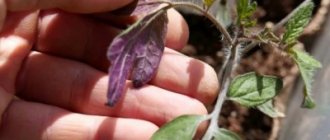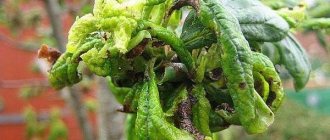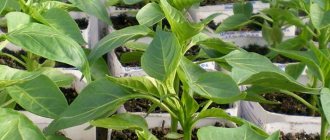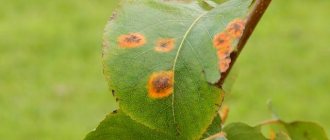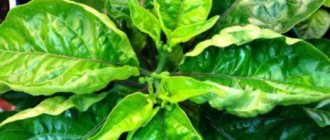Causes of the problem
Before deciding what to do with purple pepper leaves, you need to find out why they appear. A change in the natural color of the foliage to bluish pepper signals a lack of phosphorus. Also, an unusual shade can be caused by low average daily air temperatures or watering errors. Most often, vegetable growers notice that the leaves have turned purple when growing peppers in regions with a changeable, cool climate. Under unfavorable conditions, the soil is especially carefully prepared for planting vegetables and varieties that are resistant to cold are selected.
Temperature changes
Bell peppers do not tolerate sudden changes in weather. When it gets very cold, its leaves often turn blue. After this, the leaf plates are rolled up into a tube and gradually dry. A provoking factor for negative changes is the early planting of seedlings in open ground, when the soil has not yet had time to warm up well. Because of the cold, the fragile plant gets sick, its leaves begin to turn blue.
Nutrient deficiency
An imbalance of nutrients in the soil becomes another reason for changes in the color of sweet pepper foliage. Before moving the seedlings to a permanent place, the soil is prepared by saturating it with mineral and organic fertilizers. The vegetable prefers light, well-drained soil. To impart the desired qualities, sand is added to the soil in the garden bed. Loamy soil is not suitable for growing bell peppers.
Soil too dry
Sweet peppers prefer to grow in well-moistened soil. Insufficient water slows down metabolic processes in plant tissues. The leaves of the vegetable turn blue, then acquire a purple tint. If left untreated, veins clearly appear on the leaf blades. The foliage then curls and dries.
Important! Without moisture, the soil becomes too dense. Under such conditions, air does not reach the root system. As a result, the process of photosynthesis is disrupted and the shade of the leaves changes.
Phosphorus deficiency
Typically, vegetable growers pay increased attention to the nitrogen content in the soil. It is applied in the form of organic and mineral fertilizers. There is less concern about phosphorus concentration. The beds are fertilized with eggshells or phosphorus fertilizers are completely neglected. In areas where the soil does not rest, but is constantly used, the root system of plants quickly absorbs phosphorus from the soil. When the concentration of the element becomes minimal, vegetable yields decrease and susceptibility to disease increases.
The application of phosphorus fertilizers can be neglected if the soil is constantly enriched with various organic matter and left fallow after 1-2 years. Then the normal concentration of phosphorus has time to restore naturally. Otherwise, refusal to use phosphorus fertilizers will lead to a poor harvest and weak plants in the garden.
During phosphorus starvation, in addition to the purple tint of the leaves, the following changes occur:
- leaves and shoots grow deformed and underdeveloped;
- the bushes are greatly retarded in growth;
- the root system does not develop;
- productivity decreases;
- few seeds are formed in the fruits;
- the fruits grow small and irregular in shape;
- susceptibility to pathogens increases.
To avoid negative changes, phosphorus fertilizing is applied in a timely manner. The element is present in simple and double superphosphate, ammonium hydrogen phosphate, bone meal, ammophos, thermophosphate, and precipitate. Wood ash contains a small amount of phosphorus.
Anthocyanosis
With a constant lack of phosphorus, peppers develop anthocyanosis. The disease leads to gradual withering of the plant and causes death. The first sign of the development of this disease is bluish leaves. The color change then affects the stems of the pepper bush. The leaf blades curl upward or towards the stem. If untreated, anthocyanosis causes the stem to become covered with hairs and become brittle. The disease spreads to the root system. The roots weaken, become thinner and lose their ability to absorb nutrients.
Crop rotation violation
When peppers are constantly grown in one area, soil resources are used irrationally. The root system of plants consumes the nutrients necessary for the development of the vegetable. As a result, the balance of useful elements is disrupted. Pathogens and pests characteristic of nightshade crops accumulate in the soil. It is recommended to regularly change the place where vegetables are planted. Good predecessors for peppers will be legumes, melons, cereals or herbs.
Why do they turn purple?
Localization of purple spots will help determine the cause of color changes . The leaves and stem are more often subject to darkening, and less often the fruit itself. At the same time, lilac or dark purple areas on the pepper do not always indicate a plant disease.
Fruit
Purple areas on the skin of the fruit appear due to an increased concentration of the plant substance anthocyanin. Each variety of pepper contains this pigment in different quantities. The highest concentration is observed in the following varieties:
- Altai Chameleon;
- Violet Star of the East;
- Bagheera;
- Purple bell (pictured).
Therefore, purple spots on the fruit may be a feature of the variety . Anthocyanins often manifest themselves under stress: for example, a sharp drop in temperature, drought, or lack of fertilizer.
At the same time, fruit with purple dots can be eaten regardless of the cause of the color defect. Anthocyanins are beneficial to the human body and have a beneficial effect on the functioning of the immune system.
Treatment of pepper in a greenhouse
When growing peppers in greenhouse conditions, a favorable microclimate is maintained. Any violation of permissible air temperature standards, deficiency or excess of humidity cause the development of diseases in vegetable crops. For pepper bushes, drafts, sudden cold snaps or extreme heat are detrimental.
Stable temperature support
To control the temperature regime, thermometers are installed inside the greenhouses and their readings are monitored daily. To ensure a smooth change in humidity and air temperature in the room, ventilation is organized. It is carried out in the morning or late in the evening.
Important!
For greenhouse cultivation, the optimal indoor air temperature is considered to be from +20°C to +25°C. At night the temperature may drop by 3-5°. Some vegetable growers artificially increase the air temperature in the greenhouse to stimulate the growth of bushes. Such actions lead to the opposite result, harm the plant and cause its death.
In addition to air temperature indicators, soil warming is monitored. The permissible norm is from +14°C to +25°C. Lower levels provoke phosphorus starvation in pepper bushes.
To regulate the air temperature inside the greenhouse, the following methods are used:
- At night, cover the plants with an additional layer of film. It is pulled so that there is at least 5 cm of free space between it and the main shelter. The resulting air cushion will protect the plants from the cold air outside the shelter.
- Additional cover is installed inside the greenhouse to limit the amount of air above the pepper bushes. To do this, install wooden or plastic arcs over the pepper bushes and stretch a 0.5 mm thick film over them. Periodically, the shelter is removed for ventilation to prevent the air temperature from rising too much.
- To further warm the soil, lay a mulch layer. Film or spunbond is used for it. With the help of these materials, the soil warms up by 1-2 degrees.
The air temperature in the greenhouse is increased carefully. Too strong and rapid change causes leaves to wilt and cause plant death.
Fertilizer application
To improve the health of the leaves, spraying pepper bushes with a solution of copper sulfate is used. The product has a disinfecting effect and is used as a fungicide. The solution normalizes metabolic processes and helps in pest control. To prepare the solution, dissolve 100 g of copper sulfate in 10 liters of warm water. The product helps in the fight against anthocyanosis. Improvement of bushes occurs 15 days after the start of treatments.
To compensate for the deficiency of nutrients in the soil, complex mineral-organic fertilizers are applied. The root system of plants easily absorbs superphosphate. Peppers are fed with a solution of this drug after the first shoots appear. Repeated application is carried out 14 days after transplantation to a permanent place. The last time the plants can be fed with superphosphate is at the flowering stage.
Organizing proper care
When growing bell peppers in a greenhouse, following the rules of agricultural technology helps to avoid many problems. Proper care includes the following procedures:
- regularly watering pepper bushes with moderate amounts of water;
- feeding plants with fertilizers after moving to a permanent place, before flowering and at the stage of fruit formation;
- maintaining optimal temperature;
- protection from drafts and regular ventilation;
- regular inspection of plants to identify signs of disease;
- loosening the surface layer of soil after watering;
- spraying bushes to prevent diseases and pest attacks.
Brown and brown spots on the leaves of peppers and eggplants
If brownish-brown spots appear on the leaves of peppers and eggplants in your garden, this usually indicates the presence of a disease or an “attack” of pests.
Alternaria blight
The first sign of the disease is dark brown spots on the leaves of peppers and eggplants. Then it spreads to the fruits: watery spots form on them. After rain, fluff is noticeable on the plants, which gradually turns into a dark coating.
Control measures
Spraying the plant with a solution of copper oxychloride (40 g per 10 l of water) or 1% Bordeaux mixture (100 g per 10 l of water) helps against Alternaria blight.
Bacterial spot
Initially, watery spots appear on the leaves, soon they darken, become brownish-brown with a yellow border, depressed. Convex longitudinal cankers of a yellowish-brown color form on the stems.
Control measures
When these signs appear, it is necessary to spray with a 1% solution of copper sulfate.
Brown spot
Brown spot is a common fungal disease of vegetable crops.
Brown, brown and even black spots can appear on the leaves of peppers, eggplants, potatoes and tomatoes in humid, warm weather.
Control measures
To destroy the fungus that causes the disease, treatment with fungicides (Quadris, Antrakol) is required, as well as regular ventilation of the greenhouse.
Using a drip irrigation system reduces the risk of developing the disease.
Bacterial cancer
Small ulcers appear on the leaves and shoots, which subsequently turn into light brown spots with a dark edge. Soon they grow and merge, the disease spreads to the fruits, and the plant withers.
Control measures
Bacterial cancer cannot be treated - all that remains is to remove and burn damaged plants, as well as neighboring ones, to prevent spread.
Verticillium wilt
Dry brown spots with a yellowish border form on the leaves; the stem of the plant is black when cut with brown vessels. Soon the leaves dry out completely.
Typically, the disease develops in years when there are sharp alternations of frost and heat.
Control measures
Nematode
The nematode is an insidious, invisible pest that damages plant roots.
We see only signs of its vital activity: yellowish-brown spots form on the leaves, they themselves curl up at the edges, and the stems curl. If you dig up the affected plant, you will notice that the roots look like thin threads, and brown bulbs are visible on them.
Control measures
Unfortunately, it is too late to save the plant - it has died, and the nematode has already managed to do its “dark deeds”.
If you find a nematode at an early stage, you need to dig up the plants, clean the roots from the earthen clod and immerse them in hot (50-60°C) water for half an hour. A layer of soil 40 cm deep must be removed, replaced with a new one, thoroughly pour boiling water over the soil, and only then plant peppers and eggplants again.
Olive spot
Like other spots, this disease is of fungal origin.
Brown spots form on the upper side of the leaves; on the underside they are covered with an olive coating. If the disease starts, the leaves curl and fall off.
Control measures
It is necessary to combat olive spot with the help of fungicides (Quadris, Antrakol). For prevention, you need to treat the seeds and soil before planting, and also regularly ventilate the greenhouse.
Late blight
Late blight is a common “scourge” that affects both vegetable and fruit crops, as well as ornamental crops. This fungal disease develops at high humidity. If you properly care for peppers and eggplants, late blight can most likely be avoided.
The disease manifests itself not only in the characteristic brownish spots on the leaves, but also in the darkening of the root collar, as well as lodging of seedlings. If late blight is started, the fungus gradually affects the fruits of the plants.
Control measures
To defeat the disease, it is necessary to treat the plants with a fungicide (Quadris, Antrakol, Strobi), and also regularly ventilate the greenhouse.
Pepper cercospora
The leaves turn yellow and brown spots with a chloritic halo form on them. This fungal disease affects the lower leaves and rarely the fruits and stems. The upper leaves of peppers and eggplants almost never suffer from cercospora blight.
Control measures
Affected plants are removed and burned.
Many amateur gardeners or beginners in this business may sometimes notice that the pepper leaves at some point began to turn purple or acquire a slight purple tint. What is the reason and how to deal with it?
Treatment of pepper in open ground
When growing peppers in unprotected beds, purple leaves appear less frequently. The causes of the disease are cold weather and phosphorus deficiency in the soil. Without additional protection, bushes in open ground are more susceptible to the effects of bad weather. Therefore, transplanting into unprotected beds is carried out 15-20 days later than in a greenhouse. Plants are replanted after the final warm weather sets in, when the threat of return frosts has passed.
You may be interested in:
Growing bell peppers from seedlings Not a single vegetable dish or salad can do without sweet and bitter peppers. And how much more is needed for various...Read more...
Organization of additional shelter
If the weather forecast predicts a sharp drop in air temperature, the pepper beds in the garden are closed. For temporary shelter, polyethylene, spunbond or agrofibre are used. To protect the root system, the surface layer of soil is mulched with sawdust.
Advice!
Immediately after transplantation, to protect young seedlings from bright sunlight, they are covered with spruce branches. The shelter is removed after 3-4 days.
Proper watering
Bell peppers do not tolerate a lack of moisture. Plant development stops, and over time they begin to wither. Peppers are watered regularly, keeping the soil well moistened. After watering, the soil is loosened to slow down the evaporation of moisture and improve air penetration to the roots. For watering, use a moderate amount of water so that excess liquid does not stagnate at the roots.
Application of fertilizers
For open ground plants, you can use organic matter as a weekly feed:
- When dry, the soil is enriched with a mixture of humus, rotted manure, sand and wood ash.
- Mullein solution is used as root feeding. It is prepared by mixing cow dung with water in a ratio of 1:15. The liquid is poured under the root, avoiding contact with the leaves.
It is possible to fertilize with mineral fertilizers: superphosphate, urea, Agricola. For foliar spraying, use a solution of 10 liters of water and 10 ml of brilliant green. This fertilizing improves plant resistance to diseases.
White spots on pepper and eggplant leaves
Whitish-gray spots on the leaves usually indicate the presence of a fungal disease, virus, or pest attack.
Gray rot
With the development of gray rot, light gray spots can be seen on the leaves, stems and fruits of peppers and eggplants.
Typically, gray mold affects beds of peppers and eggplants when grown in a greenhouse, when the air temperature drops and humidity is high.
If the spread of the disease is not stopped in time, the plant will stop growing and die.
Control measures
If the lesion is small, you can sprinkle the sores with a mixture of copper sulfate and lime (1:2). In addition, spraying with garlic infusion helps (infuse 30 g of chopped garlic in 10 liters of water for two days).
You can also spray with Bordeaux mixture (100 g per 10 liters of water) or use a complex fungicide (for example, Antrakol).
Organization of fertilizing
The soil is enriched with nutrients even before the plants are planted in a permanent place. To prepare the soil while digging the beds, add 200 g of wood ash, 10 liters of compost, 1 tsp. to the soil for every 1 m². potassium salt, 1 tbsp. l. superphosphate.
Repeated feeding is carried out 3 weeks after transplanting the seedlings to a permanent place. To prevent the appearance of a purple tint to the foliage, from now on, fertilizers containing an increased amount of phosphorus are used. Before applying fertilizing, the soil is watered with warm water. Then a solution of 10 liters of water, 15 g of urea and 3 g of superphosphate is poured under each plant.
At the stage of active growth, fertilizing containing nitrogen, calcium and phosphorus is used 2-3 times a month. Before the flowers bloom, the bushes are watered with complex mineral fertilizers that stimulate flowering. The solution is prepared and used according to the instructions on the package.
If plants are severely deficient in phosphorus, fertilize them with a concentrated solution of superphosphate. To prepare it, pour 200 g of fertilizer into 1 liter of hot water and leave for 12 hours. Then the volume of liquid is adjusted to 10 liters. 1 liter of the prepared solution is poured under each bush.
Advice!
Additionally, foliar spraying is carried out with a solution of superphosphate at a concentration of 0.5%. The procedure helps to quickly eliminate phosphorus starvation.
Preventive measures
You can prevent color change if you start acting immediately after planting the seedlings. Basic rules from experienced gardeners:
- correct choice of site, taking into account crop rotation;
- constant inspection of the bushes, since the earlier the darkening is detected, the easier it is to stop the disease;
- surface treatment of growing peppers with a solution of copper sulfate;
- regular watering;
- use of phosphorus fertilizers.
READ MORE: Eggplant purple miracle description and characteristics of the variety, yield with photos
Pepper requires constant feeding. The first fertilizers are introduced immediately before planting. To process 1 sq. m of soil will be required:
- 8 kg of humus;
- 2 cups of ash;
- 1 tbsp. with a pile of superphosphate;
- 0.75 tbsp. l. sodium sulfate.
The second time feeding is introduced after 18-20 days. You can use the previous composition, but increase the proportion of phosphorus.
Planting and caring for sweet pepper seedlings is not a very complicated process, but it does require some knowledge to obtain healthy and strong planting material.
To avoid the appearance of pale leaves on pepper seedlings, you must:
- choose certified seeds suitable for your climate.
- Before planting, seeds must be stored in a cool place, away from direct light;
- When planting seedlings on a plot, maintain a distance of 8–10 cm between seedlings. This will provide the plants with a sufficient amount of light, and also if one bush is infected, it will make it possible to save others;
- Water the seedlings regularly, at least once a week. With insufficient watering, they may not receive the necessary nutrients;
- Prepare loose, well-drained soil for pepper seedlings. Excess moisture is an ideal environment for the development of fungus;
- fertilize the soil if necessary. Slow growth or pale leaves indicate that your plants need nutrition. Select a quality nitrogen fertilizer or compost tea and spread throughout the crop area. Follow the directions on the fertilizer package and dilute with water before fertilizing;
- remove weeds in a timely manner. They take nutrients from plants and can cause infection. Add mulch to the soil, it prevents weeds from appearing at the root;
- provide the plants with enough light, but do not allow direct rays to hit the seedlings. Direct rays can burn tender leaves;
- carefully inspect the pepper seedlings, at the slightest sign of disease or the appearance of pests, isolate the diseased plant and immediately begin treatment.
Prevention
Correct preparation of the soil for planting seedlings helps prevent phosphorus starvation and the development of anthocyanosis in peppers. To do this, it is enriched with superphosphate. Additionally, organic matter and other mineral fertilizers are added. The beds are organized taking into account the requirements of crop rotation. Peppers are not placed in places where other nightshade crops previously grew.
Grown seedlings are moved to a permanent place at the recommended time. Bushes are planted in open beds only after warm weather has finally established and the soil has warmed up. When there is a threat of cold weather, plants are covered with protective material. Temperatures in the greenhouse are monitored. If necessary, organize additional insulation or reduce the heating of the air by ventilation.
A change in the color of pepper leaves and the appearance of a purple tint indicates improper care or the onset of disease development. After discovering the reason for restoring the health of the bushes, the plants are insulated or fertilized with mineral fertilizers and organic matter.
Classification of diseases
Experts identify several groups of diseases that affect vegetable and horticultural crops (including bell peppers). The division is based on the type of pathogen.
Types of diseases:
- fungal;
- bacterial;
- viral;
- non-infectious diseases.
Most often, summer residents encounter fungal infections, which are considered the most common. The culprit is a large number of different fungi, the spores of which are carried by precipitation, wind, insects, and are stored in the soil and plant debris.
On a note! The share of fungal infections among all other plant diseases is 80%.
Viral and bacterial diseases are less common, but they are no less dangerous than fungal ones. Another difficulty is that many infections caused by viruses and bacteria have vague symptoms and are often not treatable.
The cause of non-infectious crop diseases is violations of the agricultural technology of bell pepper. The blame here lies with the summer residents, who did not supervise the plantings and did not provide them with proper care.



